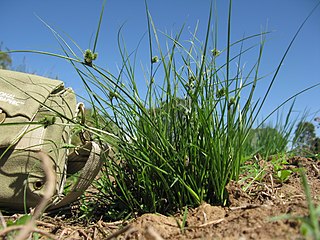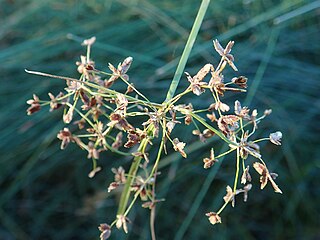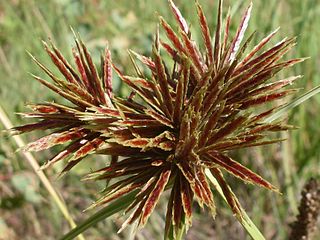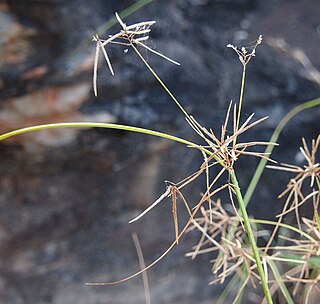
Carex inversa, commonly known as knob sedge, is a species of sedge of the family Cyperaceae that is native to parts of Australia and New Zealand and has also been introduced into Great Britain.
Cyperus alopecuroides, commonly known as the foxtail flatsedge, is a sedge of the family Cyperaceae that is native to parts of Africa, Asia and Australia.

Cyperus compressus, commonly known as annual sedge, is a sedge of the family Cyperaceae that has a wide distribution throughout countries with warmer climates. It is found in tropical areas of Africa, Asia and the Americas.

Cyperus concinnus is a sedge of the family Cyperaceae that is native to Australia, and found in New South Wales, Queensland, the Northern Territory, South Australia, Victoria and Western Australia.

Cyperus congestus, commonly known as dense flat-sedge or clustered flat-sedge, is a sedge of the family Cyperaceae that is native to southern Africa mostly in South Africa, Lesotho and Namibia.

Cyperus dactylotes is a sedge of the family Cyperaceae that is native to all of mainland Australia except for Victoria.
Cyperus digitatus, also known as finger flatsedge in the United States, and chang xiao sui suo cao in China, is a sedge of the family Cyperaceae that is native to tropical and subtropical areas of Africa, Asia, the Americas and Australia.

Cyperus gilesii, commonly known as Giles' flat-sedge, is a sedge of the Cyperaceae that is native to Australia.
Cyperus hamulosus is a sedge of the family Cyperaceae. It is native from Bulgaria east to Mongolia, and from Morocco in northAfrica down to Namibia in the south. It has also been introduced to western parts of Australia.
Cyperus ixiocarpus is a sedge of the family Cyperaceae that is native to northern parts of Australia.

Cyperus javanicus, also known as the Javanese flatsedge, is a sedge of the family Cyperaceae that is native to Indonesia and Australia.
Cyperus nutans is a sedge of the family Cyperaceae that is native to Australia, China, India, Bangladesh, south-east Asia, Malaysia, India, and Indonesia.
Cyperus rigidellus is a sedge of the family Cyperaceae that is native to Australia.

Cyperus vaginatus, commonly known as stiff-leaf sedge or stiff flat-sedge, is a sedge of the family Cyperaceae that is native to Australia.
Cyperus victoriensis, also known as channel nut grass is a sedge of the family Cyperaceae that is native to all the states and territories of mainland Australia.
Cyperus viscidulus is a sedge of the family Cyperaceae that is native to north western Australia.
Cyperus vorsteri is a sedge of the family Cyperaceae native to southern Africa.
Cyperus zollingeri, commonly known as roadside flatsedge, is a sedge of the family Cyperaceae that is native to tropical areas of Australia, Africa and Asia.
Cyperus hemisphaericus is a species of sedge that is endemic to eastern parts of Africa.

Carex gaudichaudiana, also known as fen sedge, is a tussock-forming species of perennial sedge in the family Cyperaceae. It is native to parts of Australia and New Zealand.









